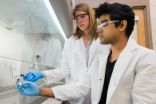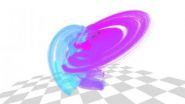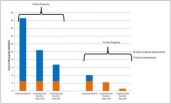(Press-News.org) By carefully watching nearly a hundred hours of video showing mother rats protecting, warming, and feeding their young pups, and then matching up what they saw to real-time electrical readings from the pups' brains, researchers at NYU Langone Medical Center have found that the mother's presence and social interactions — her nurturing role — directly molds the early neural activity and growth of her offsprings' brain.
Reporting in the July 21 edition of the journal Current Biology, the NYU Langone team showed that the mother's presence in the nest regulated and controlled electrical signaling in the infant pup's brain.
Although scientists have known for decades that maternal-infant bonding affects neural development, the NYU Langone team's latest findings are believed to be the first to show — as it is happening — how such natural, early maternal attachment behaviors, including nesting, nursing, and grooming of pups, impact key stages in postnatal brain development.
Researchers say the so-called slow-wave, neural signaling patterns seen during the initial phases of mammalian brain development — between age 12 and 20 days in rats — closely resembled the electrical patterns seen in humans for meditation and conscious and unconscious sleep-wake cycles, and during highly focused attention. These early stages are when permanent neural communication pathways are known to form in the infant brain, and when increasing numbers of nerve axons become sheathed, or myelinated, to speed neural signaling.
According to senior study investigator and neurobiologist Regina Sullivan, PhD, whose previous research in animals showed how maternal interactions influenced gene activity in the infant brain, the latest study offers an even more profound perspective on maternal caregiving.
"Our research shows how in mammals the mother's sensory stimulation helps sculpt and mold the infant's growing brain and helps define the role played by 'nurturing' in healthy brain development, and offers overall greater insight into what constitutes good mothering," says Sullivan, a professor at the NYU School of Medicine and its affiliated Nathan S. Kline Institute for Psychiatric Research. "The study also helps explain how differences in the way mothers nurture their young could account, in part, for the wide variation in infant behavior among animals, including people, with similar backgrounds, or in uniform, tightly knit cultures."
"There are so many factors that go into rearing children," says lead study investigator Emma Sarro, PhD, a postdoctoral research fellow at NYU Langone. "Our findings will help scientists and clinicians better understand the whole-brain implications of quality interactions and bonding between mothers and infants so closely after birth, and how these biological attachment behaviors frame the brain's hard wiring."
For the study, a half-dozen rat mothers and their litters, of usually a dozen pups, were watched and videotaped from infancy for preset times during the day as they naturally developed. One pup from each litter was outfitted with a miniature wireless transmitter, invisibly placed under the skin and next to the brain to record its electrical patterns.
Specifically, study results showed that when rat mothers left their pups alone in the nest, infant cortical brain electrical activity, measured as local field potentials, jumped 50 percent to 100 percent, and brain wave patterns became more erratic, or desynchronous. Researchers point out that such periodic desynchronization is key to healthy brain growth and communication across different brain regions.
During nursing, infant rat pups calmed down after attaching themselves to their mother's nipple. Brain activity also slowed and became more synchronous, with clearly identifiable electrical patterns.
Slow-wave infant brain activity increased by 30 percent, while readings of higher brain-wave frequencies decreased by 30 percent. Milk delivery led to intermittent bursts of electrical brain activity that were double or five times higher than before.
Similar spikes in rat brain activity of more than 100 percent were observed when mothers naturally groomed their infant pups.
However, these brain surges progressively declined during weaning, as infant pups gained independence from their mothers, leaving the nest and seeking food on their own as they grew past two weeks of age.
Additional experiments with a neural-signaling blocking agent, propranolol, confirmed that maternal effects were controlled in part by secretion of norepinephrine, a key neurotransmitter and hormone involved in most basic brain and body functions, including regulation of heart rate and cognition. Noradrenergic blocking in infant rats mostly dampened all previously observed effects induced by their mothers.
Sullivan says her team next plans similar experiments to look at how behavioral variations by the mother affect infant rat brain development, with the added goal of mapping any differences in brain development.
Long term, they say, they hope to develop diagnostic tools and therapies for people whose brains may have been impaired or simply underdeveloped during infancy.
Sarro says more research is also under way to investigate what other, nonadrenergic biological mechanisms might also be involved in controlling maternal sensory stimulation of the infant brain.
INFORMATION:
Funding support for the study was provided by the US National Institute of Child Health and Human Development and the National Institute of Mental Health, both parts of the National Institutes of Health. Corresponding federal grant numbers are R01 DC009910 and R01 MH0901451.
In addition to Sullivan and Sarro, Donald Wilson, PhD, also at NYU Langone, served as co-investigator for this study.
For more information, go to:
http://www.med.nyu.edu/biosketch/sullir06/publications
http://www.cell.com/current-biology/home
About NYU Langone Medical Center:
NYU Langone Medical Center, a world-class, patient-centered, integrated academic medical center, is one of the nation's premier centers for excellence in clinical care, biomedical research, and medical education. Located in the heart of Manhattan, NYU Langone is composed of four hospitals — Tisch Hospital, its flagship acute care facility; Rusk Rehabilitation; the Hospital for Joint Diseases, the Medical Center's dedicated inpatient orthopaedic hospital; and Hassenfeld Children's Hospital, a comprehensive pediatric hospital supporting a full array of children's health services across the Medical Center — plus the NYU School of Medicine, which since 1841 has trained thousands of physicians and scientists who have helped to shape the course of medical history. The Medical Center's tri-fold mission to serve, teach, and discover is achieved 365 days a year through the seamless integration of a culture devoted to excellence in patient care, education, and research. For more information, go to http://www.NYULMC.org, and interact with us on Facebook, Twitter, and YouTube.
Media Inquiries:
David March
212.404.3528│david.march@nyumc.org
Measuring nurture: Study shows how 'good mothering' hardwires infant brain
First telemetric readings in infant rat brain recorded as mother nests, nurses, and grooms pups
2014-07-17
ELSE PRESS RELEASES FROM THIS DATE:
Scripps Florida scientists identify gene that plays a surprising role in combating aging
2014-07-17
JUPITER, FL, July 17, 2014 – It is something of an eternal question: Can we slow or even reverse the aging process? Even though genetic manipulations can, in fact, alter some cellular dynamics, little is known about the mechanisms of the aging process in living organisms.
Now scientists from the Florida campus of The Scripps Research Institute (TSRI) have found in animal models that a single gene plays a surprising role in aging that can be detected early on in development, a discovery that could point toward the possibility of one day using therapeutics, even some commonly ...
Crohn's disease research
2014-07-17
University of Delaware researchers have identified a protein, hiding in plain sight, that acts like a bodyguard to help protect and stabilize another key protein, that when unstable, is involved in Crohn's disease. The fundamental research points to a possible pathway for developing an effective therapy for the inflammatory bowel disease.
The research, by Catherine Leimkuhler Grimes, assistant professor of chemistry and biochemistry at UD, and Vishnu Mohanan, doctoral student in biological sciences, is published in the July 4 issue of the Journal of Biological Chemistry. ...
Carnegie Mellon combines hundreds of videos to reconstruct 3D motion without markers
2014-07-17
PITTSBURGH—Carnegie Mellon University researchers have developed techniques for combining the views of 480 video cameras mounted in a two-story geodesic dome to perform large-scale 3D motion reconstruction, including volleyball games, the swirl of air currents and even a cascade of confetti.
Though the research was performed in a specialized, heavily instrumented video laboratory, Yaser Sheikh, an assistant research professor of robotics who led the research team, said the techniques might eventually be applied to large-scale reconstructions of sporting events or performances ...
Incidence of stroke in the elderly has dropped by 40 percent over the last 20 years
2014-07-17
Philadelphia, PA, July 17, 2014 – A new analysis of data from 1988-2008 has revealed a 40% decrease in the incidence of stroke in Medicare patients 65 years of age and older. This decline is greater than anticipated considering this population's risk factors for stroke, and applies to both ischemic and hemorrhagic strokes. Investigators also found death resulting from stroke declined during the same period. Their findings are published in the July issue of The American Journal of Medicine.
Preventable but deadly, stroke is the fourth leading cause of mortality in the ...
NYU Langone investigators to present new research at 2014 Alzheimer's Association International Conference
2014-07-17
(New York, NY, July 12, 2014) - Researchers from the Center for Cognitive Neurology (CCN) at NYU Langone Medical Center, NYU School of Medicine, and the Nathan S. Kline Research Institute will present new findings at the 2014 Alzheimer's Association International Conference in Copenhagen, Denmark, July 12 – 17, 2014.
The Center for Cognitive Neurology is a multidisciplinary, integrated center devoted to research, clinical care and clinical advances toward the treatment and cure of neurological diseases affecting cognition -- focused on memory, language, attention, auditory, ...
The rate at which groundwater reservoirs are being depleted is increasing
2014-07-17
FRANKFURT.In what parts of the world and to what degree have groundwater reservoirs been depleted over the past 50 years? The Frankfurt hydrologist Prof. Petra Döll has been researching this using the global water model WaterGAP. She has arrived at the most reliable estimate to date by taking into consideration processes which are important in dry regions of the world. The values calculated were compared with monitoring data from many different wells and data from the GRACE satellites. These satellites measure changes in the Earth's gravity field. Döll has come to the conclusion ...
What are the risks of post-traumatic stress disorder after an accident?
2014-07-17
This news release is available in French. Many patients continue to suffer from symptoms (headaches, pain) several months after an accident, which can pose a real handicap to their lives. The team of Emmanuel Lagarde, research director at Inserm's Research Centre for Epidemiology and Biostatistics (Inserm/University of Bordeaux) has studied the subsequent development of 1,300 people who were admitted to A&R between 2007 and 2009 for trauma. The researchers demonstrate that it is possible to identify people who will develop post-traumatic stress disorder, which generally ...
Danish DNA could be key to happiness
2014-07-17
Genetics could be the key to explaining nation's levels of happiness, according to research from the University of Warwick.
Economists at the University's Centre for Competitive Advantage in the Global Economy (CAGE) have looked at why certain countries top the world happiness rankings. In particular they have found the closer a nation is to the genetic makeup of Denmark, the happier that country is. The research could help to solve the puzzle of why a country like Denmark so regularly tops the world happiness rankings.
Dr Eugenio Proto and Professor Andrew Oswald ...
Potential new therapy with brain-on-a-chip axonal strain injury model
2014-07-17
University of Houston researchers have devised a new method for extracting molecules from live cells without disrupting cell development, work that could provide new avenues for the diagnosis of cancer and other diseases.
The researchers used magnetized carbon nanotubes to extract biomolecules from live cells, allowing them to retrieve molecular information without killing the individual cells. A description of the work appears this week in the Proceedings of the National Academy of Sciences.
Most current methods of identifying intracellular information result ...
Is the US National Flood Insurance Program affordable?
2014-07-17
There is often tension between setting insurance premiums that reflect risk and dealing with equity/affordability issues. The National Flood Insurance Program (NFIP) in the United States recently moved toward elimination of certain premium discounts, but this raised issues with respect to the affordability of coverage for homeowners in flood-prone areas. Ultimately, Congress reversed course and reinstated discounted rates for certain classes of policyholders.
Carolyn Kousky (Resources for the Future, USA) and Howard Kunreuther's (The Wharton School, University of Pennsylvania, ...
LAST 30 PRESS RELEASES:
$80 million in donations propels UCI MIND toward world-class center focused on dementia
Illinois research uncovers harvest and nutrient strategies to boost bioenergy profits
How did Bronze Age plague spread? A sheep might solve the mystery
Mental health professionals urged to do their own evaluations of AI-based tools
Insufficient sleep associated with decreased life expectancy
Intellicule receives NIH grant to develop biomolecular modeling software
Mount Sinai study finds childhood leukemia aggressiveness depends on timing of genetic mutation
RSS Research Award for new lidar technology for cloud research
Novel AI technique able to distinguish between progressive brain tumours and radiation necrosis, York University study finds
Why are abstinent smokers more sensitive to pain?
Alexander Khalessi, MD, MBA, appointed Chief Innovation Officer
Optical chip pioneers physical-layer public-key encryption with partial coherence
How your brain understands language may be more like AI than we ever imagined
Missed signals: Virginia’s septic strategies overlook critical timing, study warns
Delayed toxicities after CAR T cell therapy for multiple myeloma are connected and potentially preventable
Scientists find cellular key to helping plants survive in saltwater
Medical cannabis program reduces opioid use
Immunotherapy works for sepsis thanks to smart patient selection
Cardiovascular events 1 year after RSV infection in adults
US medical prices and health insurance premiums, 1999-2024
Medical cannabis and opioid receipt among adults with chronic pain
Multichannel 3D-printed bioactive scaffold combined with siRNA delivery for spinal cord injury recovery
Triaptosis—an emerging paradigm in cancer therapeutics
A new paradigm in spectroscopic sensing: The revolutionary leap of SERS-optical waveguide integration and ai-enabled ultra-sensitive detection
Sweet tooth: How blood sugar migration in diabetes affects cavity development
Lowest suicide rate is in December but some in media still promote holiday-suicide myth
Record-breaking cosmic explosion challenges astronomers’ understanding of gamma-ray bursts
Excessive heat harms young children’s development, study suggests
Quanta Books to publish popular math and physics titles by Terence Tao and David Tong
Philanthropic partnerships fund next-generation instruments for mid-sized telescopes
[Press-News.org] Measuring nurture: Study shows how 'good mothering' hardwires infant brainFirst telemetric readings in infant rat brain recorded as mother nests, nurses, and grooms pups



